Architecture plays a crucial role in determining a property’s value, influencing everything from curb appeal to long-term investment potential. Thoughtful design not only enhances the aesthetic appeal of a building but also impacts functionality, sustainability, and desirability in the real estate market.
The Link Between Architecture and Property Demand
Well-designed buildings tend to attract more buyers and command higher prices. Features such as modern facades, open-concept layouts, and high-end materials contribute to a property’s desirability. Historic buildings with preserved architectural details also hold strong appeal, offering character and uniqueness that many buyers seek. For example, 101 Spadina Condos is an upcoming project that seamlessly blends contemporary architecture with historic charm. With its elegant brickwork and sophisticated arches, it pays homage to Toronto’s architectural heritage while incorporating modern design elements that appeal to today’s urban buyers. Projects that carefully balance historical significance with modern convenience tend to attract more interest from both end-users and investors.
Functionality and Livability in Home Design
Good architecture goes beyond appearance; it enhances livability. Well-planned layouts optimize space, improve natural lighting, and create seamless indoor-outdoor transitions. High ceilings, large windows, and strategic room placement can make a home feel more spacious and inviting.
In high-rise developments, smart floor plans that minimize wasted space and maximize functionality are essential. Buyers are increasingly looking for efficient layouts that offer flexible living arrangements, home office potential, and built-in storage solutions. This has become even more relevant in the post-pandemic world, where multifunctional spaces are in high demand.
Moreover, thoughtful architecture contributes to a sense of community. Shared amenities such as rooftop terraces, co-working spaces, and fitness centers are now a standard expectation in many developments. These features not only improve residents’ lifestyles but also enhance the property’s long-term value.
The Impact of Sustainable Architecture on Value
Sustainability is becoming a key factor in real estate, with energy-efficient buildings commanding higher prices. Features such as green roofs, smart home systems, and eco-friendly materials contribute to long-term savings and environmental benefits.
New developments incorporating sustainable architecture not only attract eco-conscious buyers but also future-proof properties against changing regulations and market demands. Energy-efficient homes with solar panels, smart thermostats, and high-performance insulation often enjoy increased resale value and reduced utility costs.
Additionally, certifications such as LEED (Leadership in Energy and Environmental Design) can further enhance a building’s reputation, attracting buyers willing to pay a premium for a greener lifestyle. Many cities are now incorporating sustainability requirements into zoning laws, making it even more critical for new developments to align with eco-friendly standards.
Architectural Trends That Influence Market Appeal
Trends in architecture can significantly impact a property’s attractiveness to buyers. Some of the most sought-after architectural features in today’s market include:
- Mixed-use developments that integrate residential, retail, and office spaces.
- Minimalist and open-concept designs that maximize space and light.
- Industrial-inspired elements such as exposed brick, steel, and wood.
- Smart home integration for enhanced convenience and energy efficiency.
- Biophilic design that incorporates natural elements such as greenery and water features.
Developments that incorporate these trends tend to maintain strong demand and offer greater long-term investment potential. Buyers today seek not just a home, but a lifestyle that aligns with modern work, entertainment, and wellness needs.
How Neighborhood Architecture Affects Property Value
The architectural style of a neighborhood also plays a significant role in property values. Areas with cohesive, well-maintained designs often see higher appreciation rates than those with inconsistent or outdated buildings. Urban centers that successfully blend modern high-rises with preserved heritage buildings create dynamic streetscapes that attract both residents and investors.
For instance, neighborhoods with consistent architectural themes—whether they reflect historical charm or sleek modernity—tend to hold their value better. Cities like Toronto have zoning laws that encourage the preservation of historical architecture while allowing for contemporary development, making areas like the Entertainment District particularly appealing.
Additionally, planned infrastructure improvements such as transit expansions or new green spaces can further boost real estate values. Buyers should consider not just the design of their potential home, but also how the surrounding area’s architecture and amenities contribute to long-term desirability.
The Role of Smart Design in Future-Proofing Homes
Smart design is becoming increasingly important in real estate. Beyond aesthetics, architecture now focuses on adaptability and longevity. Features such as modular spaces, retractable walls, and convertible rooms allow properties to evolve with the changing needs of their occupants.
Technological advancements have also played a crucial role in architecture’s influence on real estate. Smart home systems that integrate security, lighting, and temperature control are now a priority for many buyers. Developers who incorporate these features into their designs position their properties for long-term success.
Additionally, health-conscious design trends are gaining momentum. Buildings with enhanced air filtration systems, touchless technology in common areas, and designated wellness spaces are becoming more appealing in light of global health concerns.
Final Thoughts
Architecture is a powerful factor in real estate, shaping both aesthetic appeal and market value. From sustainability and functionality to historical charm and modern innovation, well-designed buildings attract buyers and retain strong resale potential. Whether purchasing a new development or an existing property, considering architectural quality can lead to a smarter real estate investment.
Buyers and investors should look beyond square footage and location to evaluate the long-term impact of a building’s design. With growing trends in eco-friendly construction, mixed-use developments, and smart home integration, the future of real estate is increasingly driven by architectural innovation. By prioritizing well-planned designs, buyers can ensure that their investment remains both valuable and enjoyable for years to come.
